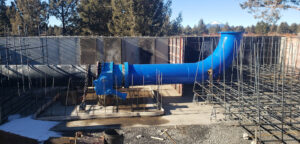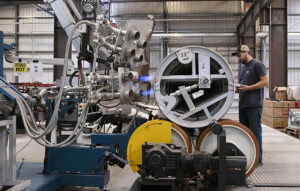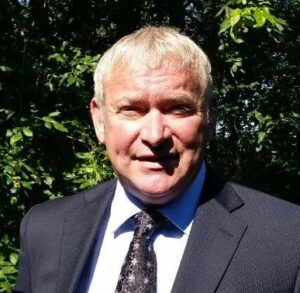Krah USA makes large-diameter high-density polyethylene (HDPE) pipes for use in the irrigation, municipal, and hydropower markets. In this interview, co- CEOs Midge Graybeal and Mark Theetge and consultant Marc Thalacker, the manager of an irrigation district in Oregon, tell us about how municipalities, utilities, mines, marinas, and other customers are turning to the company’s products for a wide range of applications.
Hydro Leader: Please tell us about your backgrounds and how you came to be in your current positions.
Midge Graybeal: Marc Theetge and I are the co-CEOs of Krah USA. I have worked as a facilities manager for large corporations, a marketing and events manager, and a project assistant for engineering firms, concentrating on the built environment and water infrastructure for about 30 years. These firms designed and constructed water and wastewater facilities, process piping, and other facilities for corporations, irrigation districts, industrial and food processing plants, and municipalities. Now, Mark and I provide products for infrastructure projects throughout the western United States.
Mark Theetge: I am a co-CEO and the chief sales officer for Krah USA. I’ve been a polyethylene product specialist for my entire career, which spans over 30 years. I have worked with owners, engineers, and end users in the polyethylene industry. I was always looking for the next product to sell that would help projects in progress. For over 25 years now, I’ve built a relationship with Marc Thalacker and Midge Graybeal, and over the years, we’ve discussed how we could sell a polyethylene and polypropylene product here in the United States. Now, we have a state-of-the-art engineered product that will be well received for agricultural, hydroelectric, and municipal use.
Marc Thalacker: I manage Three Sisters Irrigation District (TSID) in Sisters, Oregon. The first big project I did with Mark was in 2008, when TSID’s WaterSMART application was number 1 in the country out of 200 applications. I purchased 20,000 feet of 54‑inch HDPE pipe from him. We’ve now piped 60 of the 65 miles of canals in the district, and we’re in the process of piping the last 5. In November, Krah delivered 9,500 feet of 24‑inch pipe to the district for installation during December. TSID is unusual in that we do all our own construction when we put in piping projects. In addition to that, we’re basically the only people in Oregon who have built hydro plants in the last couple of years. We built one in 2014 and one in 2018, and we are now building a third. Throughout the years, of the 60 miles of pipe I mentioned, and of another 60 miles of on-farm pipe, I’ve bought well over half from Mark. I’ve had a chance to learn about HDPE from him. Through my involvement with numerous organizations, I have become an adviser for irrigation districts throughout the West.
Midge Graybeal: Together, we have expertise in engineering and marketing; in pipe manufacturing, design, and sales; and in pipe construction and installation. We bring a deep knowledge in all three areas and can deliver excellent service to our clients.
Hydro Leader: How does Krah USA relate to the German company Krah?
Midge Graybeal: We are independently owned and are not a subsidiary of Krah. Krah USA and the other Krah companies are part of the Krah family, meaning that they can advise us and help us find the material or information that we need. We just took the name of the German company and have the rights to use it.
There are 90 other Krah plants around the world, including in Argentina, Croatia, Estonia, Germany, Japan, the Phillippines, and Saudi Arabia. Eventually, when we get past the COVID‑19 pandemic, we’ll get to host the biannual Krah fly-in. All the lead teams of the other Krah plants in the other countries will come to the United States to visit Krah USA. We’re looking forward to that.

Hydro Leader: Would you tell us more about the company?
Midge Graybeal: We founded Krah USA in December 2019. It was a fast-tracked project. We got our lease in July 2020, received our first equipment in November, and were producing pipe by December of that year. With two pieces of equipment, we can make pipe that ranges in diameter from 4 to 196 inches. Our first project was for 60‑inch pipe. Our clients include irrigation districts, municipalities, hydropower plants, tide gates, landfills, and oil and gas companies, among others. We also make solid-wall profile pipe, manholes, fittings, tanks, and silos. We provide CPR profile pipe for tide gates, and we provide welding services. Mark even designed and manufactured a water tank for a winery in southern Oregon. Ultimately, we will be providing consulting services so that we can help clients design their pipes in the most efficient and cost-effective way.
We decided to locate our company in the Prineville area because there is a lot of infrastructure money from the federal government coming in through the irrigation districts. We realized there were not a lot of other manufacturing companies in the area, and we knew that the local consumers were paying up to $5,000 per truck to bring in large pipe. In Oregon, we are well located to supply pipe to the entire western United States. We’re already shipping to Alaska, California, Idaho, Oregon, and Washington, and we’re working on projects in Colorado and Utah. Our clients spend significantly less on shipping than they would if they were to order pipe from the East Coast, Texas, or Canada.
Marc Thalacker: The Krah product allows Krah USA to build manholes and manifolds and things of that nature, so Krah USA could go into a wastewater treatment project, build all the tanks and structures inside the plant, hook up all the plumbing, and run lines out to connect the sewers coming in. Krah USA expects federal infrastructure money to fund more large wastewater projects that require manholes and plant tanks.
Hydro Leader: How many people do you employ?
Midge Graybeal: We have a core of 12 and plan to eventually hire up to 30.

Marc Thalacker: Krah USA also has a lot of auxiliary products and services to offer. For instance, Krah USA is working with outside contractors performing welding and installation on a 33‑ and 36‑inch solid-wall pipe for an irrigation district in Washington. In addition to having its own truck, Krah USA works with multiple trucking firms and contractors who ship pipe to projects all over the Northwest.
Hydro Leader: What are the advantages of HDPE pipe, and how does Krah’s HDPE differ from others on the market?
Mark Theetge: There really isn’t anything like it. There are traditional solid-wall pipes that are produced as extruded, but we wind with mandrels, so we can basically manipulate material to any process. That’s something that can’t be done elsewhere in the United States. We see ourselves as providing the next generation of what people will be using. The next generation of piping products are engineered for specific use and longevity and range in size from 24 to 196 inches. Other corrugated or profiled products can’t reach the pressures or the stiffness that we can. Krah pipe can be used in the conveyance of any fluid or gas appropriate to the properties of the material, including
potable, raw, and reclaimed water; methane gas; and foul air. It seems like everything, at least in this industry, starts in Europe eventually reaches the United States.
Midge Graybeal: Another benefit of our product is that it enables electrofusion welding, which is easy to do right in the field. It’s not a traditional weld. The product is chemical resistant, microorganism resistant, and abrasion resistant. Mark can tell you that he has run trucks over the pipe, and it doesn’t break: It’s impact resistant. Since we are in the Northwest, it’s important that plastic pipes are seismic compatible. When the ground undulates, they undulate, too, and won’t crack or break like PVC or concrete does. HDPE won’t rust like steel does. It has a 100+ year shelf life; we have a 50‑year warranty on our product right now. Another advantage is that we can put colors inside the pipes—blue for water, green for wastewater, and yellow to attract fish to screens and passage for culverts.
Marc Thalacker: I’ve spent 25 years tearing out steel, PVC, and concrete to replace them with HDPE pipe. The district’s operations and maintenance needs have almost gone to zero, because the only time you ever need to fix HDPE pipe is when someone accidentally hits it with a backhoe. It’s incredibly tough. Another thing I love about the product is that it bends, so it fits in winding ditches. Aging infrastructure is the number 1 issue in western water, so I always wondered why you would put in a product that you have to replace in 30–50 years when you can put something in that’s got a potential shelf life of 100–1,000 years. That’s why I chose HDPE pipe.
Midge Graybeal: In the age of reduce, recycle, and reuse, many cities, municipalities, and now even irrigation districts want to have a certain percentage of reused material in their products. That was the case with the city of Prineville. A huge advantage of our HDPE pipe is that it’s 100 percent recyclable. If people order pipes and decide they’re too small, we can dig them up, put in a bigger pipe, break down the old pipe into pellets, and reuse it. Producing the pipe literally creates no waste, no chemicals, and no gas fumes. Today, it’s important that people know there is nothing going to the landfill.
Hydro Leader: Please discuss your products of interest for the hydropower industry.
Mark Theetge: I worked on a penstock project with PacifiCorp, which started my interest in discovering new products for use. PacifiCorp removed a 100‑year-old, 120‑inch-diameter pipe and replaced it with polyethylene. At the time of my investigation more than 20 years ago, large-diameter profile-wall pipes in the United States were limited to 22 pounds per square inch (psi). The market that existed was for pipe above that pressure level. I saw the need for a product, unlike steel, that was resistant to the abrasive suspended material that is typically found in raw water. Outside the United States, Krah was developing pipes that had a pressure rating of 125 psi. It offered a higher-pressure pipe made from a material that was resistant to the abrasive elements. The pipe also had a higher mechanical efficiency, eliminating the need for some of the maintenance that steel piping would require. This focused my interest in bringing Krah to the United States.
Marc Thalacker: Before I started building hydro plants for TSID, I spent time driving all over the Northwest and the West, looking at hydro facilities that had been installed to see what had gone right and what had gone wrong. I saw a lot of what had gone wrong. One of the things that I realized was that because penstocks are so difficult, most people had installed steel penstocks at high pressure. The problem was that they wore out after around 30 years. That is problematic. I build my hydro facilities to last a minimum of 100 years, which makes them a much more viable renewable product. Wind turbines have a limited lifespan, after which they literally have to be replaced, and solar panels only last a certain number of years, but with hydro facilities, you can rebuild the turbine after 30–50 years and continue to run it. I was concerned about hydro facilities using steel pipe, encased in a 5‑foot block of concrete, to lead up to the turbine shutoff valve. With the one I’m building right now, the HDPE pipe goes all the way inside the plant, so I will never have to touch, replace, fix, or slipline it over the 100‑year lifespan of the turbine. In Japan, Krah manufacturers have gotten some of their penstocks all the way up to 200–300 psi. It is a challenge to weld large pipes with diameters above 72 inches, but there are a limited number of fusing machines that can weld HDPE solid-wall pipe with diameters from 72 inches all the way up to 138 inches. In the long term, there will be the opportunity for Krah USA to build large-diameter penstocks.
Hydro Leader: How can prospective customers get in touch with you?
Midge Graybeal: I would encourage anybody to give Mark a call or to send an e-mail to sales@krahusa.com or marktheetge@krahusa.com. We’re doing tours almost every week for organizations from across Oregon and Washington. If a group wants to tour the plant, we’d be happy to show them what we’re doing.
Midge Graybeal and Mark Theetge are co-CEOs of Krah USA. They can be contacted at sales@krahusa.com, marktheetge@krahusa.com, or (888) 457‑2487. Marc Thalacker manages the Three Sisters Irrigation District and works as a consultant for Krah USA.




